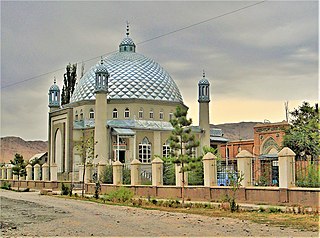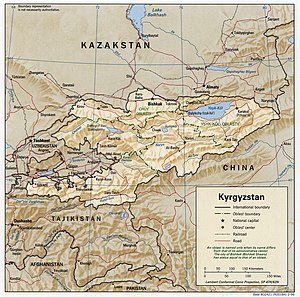
Kyrgyzstan, officially the Kyrgyz Republic, is a landlocked country in Central Asia, lying in the Tian Shan and Pamir mountain ranges. Bishkek is the capital and largest city. Kyrgyzstan is bordered by Kazakhstan to the north, Uzbekistan to the west, Tajikistan to the south, and China to the east and southeast. Ethnic Kyrgyz make up the majority of the country's over 7 million people, followed by significant minorities of Uzbeks and Russians.

Kyrgyzstan is divided into seven regions. The capital, Bishkek, is administered as an independent city of republican significance, as well as being the capital of Chüy Region. Osh also has independent city status since 2003.

The vast majority of people in Kyrgyzstan are Muslims; as of 2020, 90% of the country's population were followers of Islam. Muslims in Kyrgyzstan are generally of the Sunni branch, mostly of the Hanafi school, which entered the region during the eighth century. Most Kyrgyz Muslims practice their religion in a specific way influenced by shamanic tribal customs. There has been a revival of Islamic practices since independence in Kyrgyzstan. For the most part religious leaders deal only with issues of religion and do not reach out to communities, but rather offer services to those who come to the mosque. There are regional differences, with the southern part of the country being more religious. Kyrgyzstan remained a secular state after the fall of communism, which had only superficial influence on religious practice when Kyrgyzstan was a Soviet republic, despite the policy of state atheism. Most of the Russian population of Kyrgyzstan is Russian Orthodox. The Uzbeks, who make up 14.9 percent of the population, are generally Sunni Muslims.

Osh is the second-largest city in Kyrgyzstan, located in the Fergana Valley in the south of the country. It is often referred to as the "capital of the south". It is the oldest city in the country and has served as the administrative center of Osh Region since 1939. The city has an ethnically mixed population of 322,164 in 2021, comprising Kyrgyz, Uzbeks, Ukrainians, Koreans, and other smaller ethnic groups.

Sunni Islam is, by far, the most widely practiced religion in Tajikistan. Sunni Islam of the Hanafi school is the recognized religious tradition of Tajikistan since 2009. According to a 2009 U.S. State Department release, the population of Tajikistan is 98% Muslim,, with some Sufi orders.
The Tulip Revolution, also known as the First Kyrgyz Revolution, led to then-President Askar Akayev's fall from power. The revolution began after parliamentary elections on 27 February and 13 March 2005. The revolutionaries alleged corruption and authoritarianism by Akayev, his family and supporters. Akayev fled to Kazakhstan and then to Russia. On 4 April 2005, at the Kyrgyz embassy in Moscow, Akayev signed his resignation statement in the presence of a Kyrgyz parliamentary delegation. The resignation was ratified by the Kyrgyz interim parliament on 11 April 2005.

Solomon Islands is an overwhelmingly Christian majority country, with adherents of Islam being a minuscule minority. Because of the secular nature of the country's constitution, Muslims are free to proselytize and build places of worship in the country. The arrival of the Islamic Religion in the country can be traced back to the early 1980s. Ahmadiyya, however, first reached Solomon Islands probably in 1987, when a Ghanaian missionary by the name of Al-Hajj Hafiz Ahmad Jibreel Saeed, belonging to the Ahmadiyya Muslim Community, visited Guadalcanal on a reconnaissance trip lasting three years. Today, there are two major Islamic branches (sect) in the country, the Ahmadiyya Muslim Community and Sunni Islam. According to a 2007 report by the United States Department of State's International Religious Freedom Report, there are approximately 350 Muslims in the country. However, in 2008, an article in the Australian Journal of International Affairs suggested that there may be as many as 1,000 Ahmadiyya in the country alone, or 0.14% of the population.

The Ahmadiyya branch of Islam has been subjected to various forms of religious persecution and discrimination since the movement's inception in 1889. The Ahmadiyya Muslim movement emerged within the Sunni tradition of Islam and its adherents believe in all of the five pillars and all of the articles of faith required of Muslims. Ahmadis are considered non-Muslims by many mainstream Muslims since they consider Mirza Ghulam Ahmad, the founder of the movement, to be the promised Mahdi and Messiah awaited by the Muslims.

Islam is the main religion in Kyrgyzstan and the constitution guarantees freedom of religion.
The history of the Jews in Kyrgyzstan is linked directly to the history of the Bukharan Jews of Uzbekistan. Until the 20th century, most Jews living in the Kyrgyz areas were of the Bukharian Jewish community. However, during the 20th century, large amounts of European Jews began to emigrate to Kyrgyzstan which was then part of the Soviet Union, and a small amount of them still live in the country.

Ahmadiyya, officially the Ahmadiyya Muslim Jama'at (AMJ) is an Islamic messianic movement originating in British India in the late 19th century. It was founded by Mirza Ghulam Ahmad (1835–1908), who said he had been divinely appointed as both the Promised Mahdi and Messiah expected by Muslims to appear towards the end times and bring about, by peaceful means, the final triumph of Islam; as well as to embody, in this capacity, the expected eschatological figure of other major religious traditions. Adherents of the Ahmadiyya—a term adopted expressly in reference to Muhammad's alternative name Ahmad—are known as Ahmadi Muslims or simply Ahmadis.

Christianity has a long history in Kyrgyzstan, with the earliest archaeological remains of churches belonging to the Church of the East in modern-day Suyab dating back to the 7th century. By the 9th century an archdiocese of the Church of the East cared for the Christians of Kyrgyzstan and adjacent areas in eastern Turkestan. Although primarily Turkic there was also an Armenian community in what today is Kyrgyzstan by the 14th century. By the 15th century, however, there were no longer ecclesiastical structures of any church caring for what is today Kyrgyzstan and Islam gained the ascendancy amongst the Kyrgyz people.

Ahmadiyya is an Islamic branch in Indonesia. The earliest history of the community in Indonesia dates back to the early days of the Second Caliph. During the summer of 1925, roughly two decades prior to the Indonesian revolution, a missionary of the Community, Rahmat Ali, stepped on Indonesia's largest island Sumatra. He established the movement with 13 devotees in Tapaktuan, in the province of Aceh. The Community has an influential history in Indonesia's religious development. However, in the modern times it has faced increasing intolerance from religious establishments in the country and physical hostilities from radical Muslim groups. The Association of Religion Data Archives estimates around 400,000 Ahmadi Muslims, spread over 542 branches across the country.

The Ahmadiyya Muslim Community was established in the United Kingdom in July 1913 as one of the oldest Islamic associations in the UK. The community has built its presence with the establishment of significant sites such as The London Mosque in 1926. Over the decades the community has grown and become known for its annual convention the Jalsa Salana, interfaith dialogues and humanitarian efforts. The UK has also served as the headquarters of the community since 1984 currently in Islamabad, Tilford, in Surrey.

Ahmadiyya is an Islamic religious movement originating in 1889 in northern India around the teachings of Mirza Ghulam Ahmad (1835–1908), who claimed to have been divinely appointed as both the promised Mahdi and Messiah expected by Muslims to appear towards the end times.

The Ahmadiyya Muslim Community is the second largest group of Islam in Ghana after Sunni Islam. The early rise of the Community in Ghana can be traced through a sequence of events beginning roughly at the same time as the birth of the Ahmadiyya movement in 1889 in British India. It was during the early period of the Second Caliphate that the first missionary, Abdul Rahim Nayyar was sent to what was then the Gold Coast in 1921 upon invitation from Sunni Muslims in Saltpond. Having established the movement in the country, Nayyar left and was replaced by the first permanent missionary, Al Hajj Fadl-ul-Rahman Hakim in 1922.

Ahmadiyya is a community in Ireland under the spiritual leadership of the caliph in London. The Community was formally registered in the country in 1992, during the era of the Fourth Caliphate. Today there are two Ahmadiyya mosques in the country, one of which is purpose-built, representing up to 500 Ahmadis in the country.

Ahmadiyya is an Islamic religious community in Singapore. The Community was established during the era of the Second Caliphate, shortly before the Second World War. Ghulam Hussain Ayyaz was the first missionary sent to the region, who under the direction of the caliph, arrived in 1935, in a period when the territory was part of the Straits Settlements. In the 1970s, the Community had roughly 200 followers, represented by 1-2% of the Muslim population.

Uran Toktonazarovich Botobekov is a Kyrgyz scholar, journalist, diplomat and publicist. He was an opposition activist until 2016 when he emigrated. He is also the author of more than 60 scientific and analytical articles on politics, religion, and economy of the post-Soviet Central Asian states. His scientific works were published in magazines in several countries.
Zholbors Zhorobekov is a Kyrgyz political scientist. For most of his career he was a professor at the Jusup Balasagyn Kyrgyz National University, and from 1995 to 1999 he was an acting member of the Kyrgyz parliament. He was also the head of the State Commission on Religious Affairs of the Kyrgyz Republic. He has been a provost of the Bishkek Humanities University, and chair of the Social Science and Humanities Department of the Kyrgyz State Law Academy.











